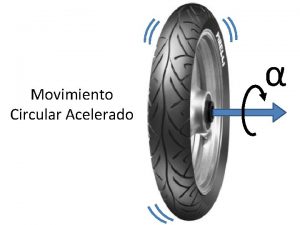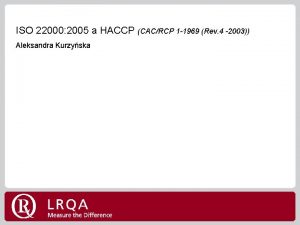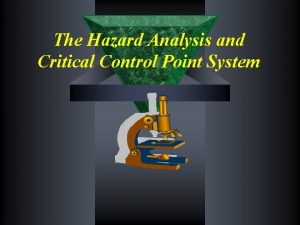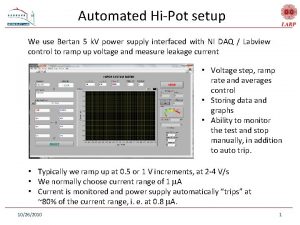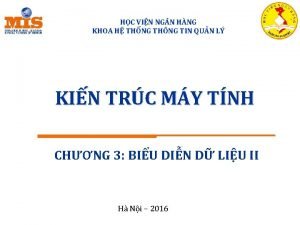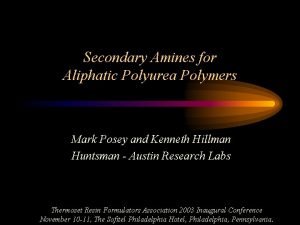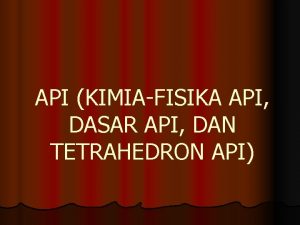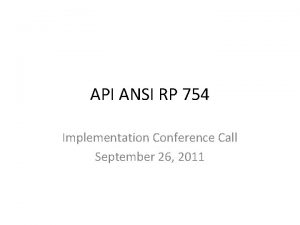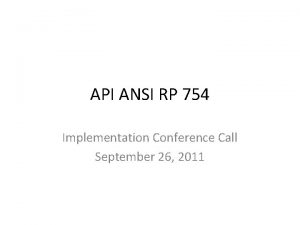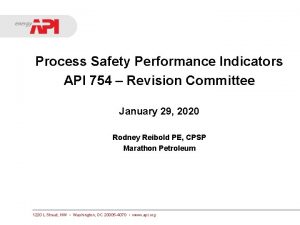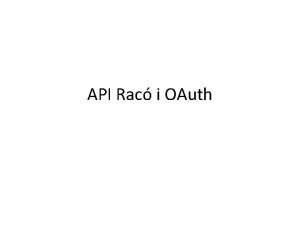API RP 754 Rev 3 June 22 2020













- Slides: 13

API RP 754 Rev. 3 June 22, 2020 GHS Statement Overlay Sub-Committee

GHS Statement Overlay Sub-Committee Eric Atkins (Olin) John Grabowski (Citgo) Marty Martin (Dow Chemical) Jim Muoio (Celanese – Representing American Chemistry Council) Bill Ralph (BP)

Real Life Situation (Email received June 18) Hi Jim, I have a question regarding API 754 that I am hoping you can help me with… XXXX from ACC suggested that I should contact you. My question is regarding how to determine the Threshold Quantity (TQ) value for Organic Peroxides. See attached example of SDS. As you know, in order to classify an event per API 754, there is some information that is required to determine the TQ values. Some of this information includes: 1. 2. 3. 4. Toxic Inhalation Hazard (TIH) Zone If TIH not available, find the Flammability - Flash Point and Boiling Point If TIH or Flash Point, Boiling Point are not available, find the Corrosiveness (p. H) If TIH, Flash Point, Boiling Point or p. H are not available, then find the Packing Group The issue with organic peroxides, is the fact that there is no data available for TIH, Flash Point, Boiling Point, Corrosiveness or Packing Group, as you can see in the attached SDS. In the past 49 CFR 172. 101 - Hazardous Materials Table, included a Packing Group II designation for Organic Peroxides of this type. This information is no longer there. I am assuming this is due to the fact that the US DOT Pipeline and Hazardous Materials Safety Administration (PHMSA) finalized a rule in 2016 to remove the Packing Group II designation for organic peroxides and self-reactive substances. Thus, since none of the physical properties (1 – 4) listed above are available for these types of chemicals (as you can see on the attached SDS), is there any other type of physical properties/information that one could use to find the Threshold Quantity values (Indoor and Outdoor) for Organic Peroxides? This information will be extremely helpful to us, as we need to accurately classify any events related to Organic Peroxides. Thank you so much for your help! Best Regards, XXXXXX

Changes in Table from May Meeting H 228 – Flammable solids (cat 1, 2) Placed in TRC-5. H 250 – Pyrophoric liquids/solids (cat 1) Placed in TRC-5. H 240 – Self-reactive substances/mixtures & organic peroxides (type A) Placed in TRC-6 H 241 – Self-reactive substances/mixtures & organic peroxides (type B) Placed in TRC-6 H 242 – Self-reactive substances/mixtures & organic peroxides (type C-F) Placed in TRC-6 H 272 – Oxidizing liquids/solids (cat 1) Placed in TRC-6 H 272 – Oxidizing liquids/solids (cat 2, 3) Placed in TRC-7 H 227 – Combustible/flammable liquids (cat 4) Placed in TRC-7; added clarifier [when released at or above flashpoint and no upper flashpoint] H 227 – Combustible/flammable liquids (cat 4) Remains in TRC-8; added clarifier [when released below flashpoint]

Hazard Class Comparison (Old vs New-Draft) Threshold Release Category TRC-1 Existing RP 754 Material Hazard Classification New RP 754 GHS Material Hazard Classification TIH Zone A Materials H 330 Fatal if inhaled, Acute toxicity, inhalation (chp 3. 1) cat (1) TIH Zone B Materials H 330 Fatal if inhaled, Acute toxicity, inhalation (chp 3. 1) cat (2) TRC-2 H 310 Fatal in contact with skin, Acute toxicity, dermal (chp 3. 1) cat (1) TIH Zone C Materials H 331 Fatal if inhaled, Acute toxicity, inhalation (chp 3. 1) cat (3) TRC-3 H 310 Fatal in contact with skin, Acute toxicity, dermal (chp 3. 1) cat (2) TIH Zone D Materials H 332 Fatal if inhaled, Acute toxicity, inhalation (chp 3. 1) cat (4) TRC-4 H 311 Fatal in contact with skin, Acute toxicity, dermal (chp 3. 1) cat (3)

Hazard Class Comparison (Old vs New-Draft) Threshold Release Category Existing RP 754 Material Hazard Classification New RP 754 GHS Material Hazard Classification Flammable Gases H 220 Extremely flammable gas, Flammable gases (chp 2. 2) (cat 1 A) Liquids with Normal Boiling Point £ 35 °C (95 °F) and Flash Point < 23 °C (73 °F) H 224 Extremely flammable liquid and vapor, Flammable liquids (chp 2. 6) (cat 1) H 228 Flammable solid, Flammable solids (chp 2. 7) (cat 1, 2) H 230 May react explosively even in the absence of air, Flammable gases (chp 2. 2) (cat 1 A, A) H 231 May react explosively even in the absence of air at elevated pressure and/or temperature, Flammable gases (chp 2. 2) (cat 1 A, B) TRC-5 Other Packing Group I Materials (excluding acids/bases) H 232 May ignite spontaneously if exposed to air, Flammable gases (chp 2. 2) 1 A, (cat 1 A pyrophoric gas) H 250 Catches fire spontaneously if exposed to air, Pyrophoric liquids and Pyrophoric solids (chp 2. 9 & 2. 10) (cat 1) H 260 may ignite spontaneously, Substances and mixtures which, in contact with water, emit flammable gases (chp 2. 12) (cat 1) H 312 Harmful in contact with skin, Acute toxicity, dermal (chp 3. 1) (cat 4)

Hazard Class Comparison (Old vs New-Draft) Threshold Release Category Existing RP 754 Material Hazard Classification Liquids with Normal Boiling Point > 35 °C (95 °F) and Flash Point < 23 °C (73°F) New RP 754 GHS Material Hazard Classification H 225 Highly flammable liquid and vapor, Flammable liquids (chp 2. 6) (cat 2) H 221 Flammable gas, Flammable gases (chp 2. 2) (cat 1 B, 2) H 240 Heating may cause an explosion, Self-reactive substances and mixtures and Organic peroxides (chp 2. 8 & 2. 15) (type A) H 241 Heating may cause a fire or explosion, Self-reactive substances and mixtures and Organic peroxides (chp 2. 8 & 2. 15) (type B) TRC-6 Other Packing Group II Materials (excluding acids/bases) H 242 Heating may cause a fire, Self-reactive substances and mixtures and Organic peroxides (chp 2. 8 & 2. 15) (type C-F) H 261 emit flammable gases, Substances and mixtures which, in contact with water, emit flammable gases (chapter 2. 12) (cat 2, 3) H 271 May cause fire or explosion; strong oxidizer, Oxidizing liquids and Oxidizing solids (chp 2. 13 & 2. 14) (cat 1)

Hazard Class Comparison (Old vs New-Draft) Threshold Release Category Existing RP 754 Material Hazard Classification New RP 754 GHS Material Hazard Classification Liquids with Flash Point ³ 23 °C (73 °F) and £ 60 °C (140 H 226 Flammable liquid and vapor, Flammable liquids (chp 2. 6) (cat 3) °F) TRC-7 Liquids with Flash Point > 60 °C (140 °F) released at a temperature at or above Flash Point H 227 Combustible liquid, Flammable liquids (chp 2. 6) 4 (cat 4) [**Released at or above flashpoint and no upper flashpoint**] strong acids/bases (see definition) H 314 Causes severe skin burns, Skin corrosion/irritation (chp 3. 2) (cat 1, 1 A) UNDG Class 2, Division 2. 2 (non-flammable, non-toxic gases) excluding air H 270 May cause or intensify fire; oxidizer Oxidizing gases (chp 2. 4) (cat 1) H 272 May intensify fire; oxidizer, Oxidizing liquids and Oxidizing solids (chp 2. 13 & 2. 14) (cat 2, 3) Other Packing Group III Materials H 318 Causes serious (irreversible) eye damage, Serious eye damage/eye irritation (chp 3. 3) (cat 1) TRC-8 Liquids with Flash Point > 60 °C (140 °F) and £ 93 °C (200 °F) released at a temperature below Flash Point H 227 Combustible liquid, Flammable liquids (chp 2. 6) 4 (cat 4) [**Released below flashpoint**] Moderate acids/bases (see definition) H 314 Causes severe skin burns, Skin corrosion/irritation, (chp 3. 2) (cat 1 B) H 319 Causes serious eye (reversible) irritation, Serious eye damage/eye irritation (chp 3. 3) (cat 2/2 A) H 370 Causes damage to organs, Specific target organ toxicity, single exposure (chp 3. 8) (cat 1)

Hazard Class Comparison (Old vs New-Draft) • Information below may be added to the footnote of the Table. Classes have been limited to acute events and events that have relevance to Process Safety: Not included: Explosives (2. 1), Aerosols (2. 3), Gases under Pressure (2. 5), Self Heating Substance (2. 11), Corrosive to Metals (2. 16), Oral Acute Toxicity (3. 1), Respiratory and Skin Sensitization (3. 4), Germ Cell Mutagenicity (3. 5), Carcinogenicity (3. 6), Reproductive Toxicity (3. 7), Specific Target Organ Toxicity - repeated exposure (3. 9), Aspiration hazard (3. 10), Hazardous to the Aquatic Environment (4. 1), and Hazardous to the Ozone Layer (4. 2) *Not all GHS classifications align with UNDG TIH classes. For Acute toxicity, the Hazard Category must also be known; the Hazard Statement does not distinguish between Category 1 & 2. This is also the case for H 314 for which only category 1 A is considered for Tier 1 TQs. Hazard Statements and Categories from GLOBALLY HARMONIZED SYSTEM OF CLASSIFICATION AND LABELLING OF CHEMICALS (GHS) Seventh revised edition, see Annex C for GHS chapters related to Hazard Statements and Categories.

Results Companies may see an increase in Tier 1 s, an increase or decrease in Tier 2 s, and so forth (i. e. may affect Tier 3 counts if tracked) while no change in performance. This approach should make companies more consistent in determining API RP 754 threshold quantities (TQ). [But there are still differences between some companies’ SDS. ] May drive other widely used chemical TQ lists to adapt this method of hazard quantification.

Next Steps Finalize hazard categorization • Organic Peroxides, Strong Oxidizers, Flammable Solids, Self-Reactive Chemicals, and Contact with Water Emits Flammable Gas may not reside in the final position in the table; • Asphyxiants (currently under T 1 -7: UNDG Class 2, Division 2. 2 (non-flammable, non-toxic gases) excluding air). Still undecided; no clear GHS category. • Further evaluate location in table for Acute Toxic Dermal exposures. Update table(s) with feedback from other teams • Strong, moderate, and weak acids/bases; Do these remain as TRC-7 (strong) and TRC-8 (moderate)? • Indoor/Outdoor affects of non-volatile, non-flammable, non-toxic chemicals. Do these TQs need to be adjusted? If so, need to determine how to represent in the Table. If approved, update API RP 754 document where TQ table changes modifies examples in Annexes.

GHS Statement Overlay Historical Comparison Eric Atkins (Olin) Kevin Hersey (Corteva Agriscience) Jim Muoio (Celanese) Bill Ralph (BP) Rodney Reibold (Marathon Petroleum)

Other Discussion: Q&A
